The 51st Japan Foundation Awards Report on the 2024 Japan Foundation Awards Ceremony
May 27, 2025
【Special Feature 084】
The year 2024 marked the 51st anniversary of the Japan Foundation Awards, first held in 1973, one year after the Japan Foundation had been established. Every year, the awards are presented to individuals and organizations that have made significant contributions to mutual understanding and friendship between Japan and other countries through academic, artistic, or other cultural pursuits. Past recipients include such luminaries as Bernard H. Leach (potter, 1974), Kurosawa Akira (film director, 1982), Donald Keene (professor of Japanese literature, Columbia University, 1983), Ozawa Seiji (music director, Boston Symphony Orchestra, 1988), Miyazaki Hayao (animated film director, 2005), Murakami Haruki (writer and translator, 2012) and Cai Guo-Qiang (artist, 2016). (Information in parentheses: award year and position held at the time)
Recipients of the 51st Japan Foundation Awards included one individual and two organizations: Shiota Chiharu (artist) from Japan, Association of Japanese Language Teachers of Mongolia from Mongolia, and Sainsbury Institute for the Study of Japanese Arts and Cultures (SISJAC) from the UK. This is a report on the award ceremony held in Tokyo on October 16, 2024.
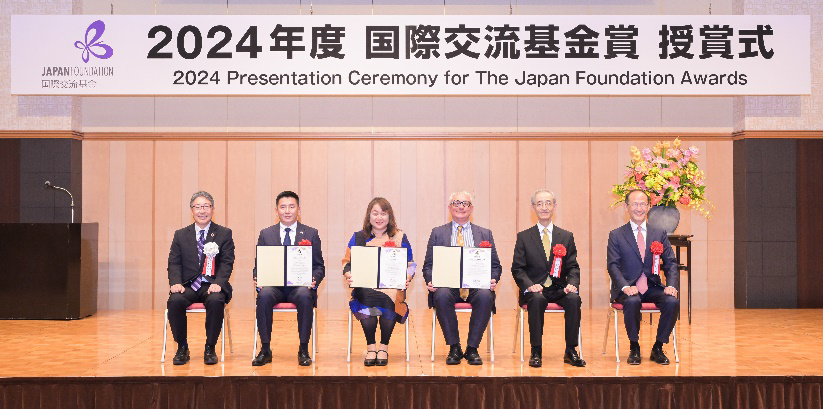
The Japan Foundation Awards is one of the oldest programs of the Japan Foundation, with 207 recipients (individuals and organizations) from 35 countries across the world as of 2023. As in past years, nominations in 2024 were made by academics in various fields from around the world and also solicited from the public based on the themes of Arts and Cultural Exchange, Japanese-Language Education Overseas, and Japanese Studies and Global Partnerships, which make up the core of the Japan Foundation's activities. From among 60 nominations, recipients were chosen by a selection committee of 20 intellectuals.
The award ceremony held on October 16 in Tokyo was attended by approximately 200 people, including the award recipients, organization representatives, the selection committee, and others, with Suzuki Hideo, Ambassador for Public Diplomacy, Ministry of Foreign Affairs of Japan, invited as a special guest in honor of the 51st anniversary of the Japan Foundation Awards. A reception honoring the award recipients was held after the ceremony.

Ambassador Suzuki offered an address at the award ceremony, congratulating the 2024 Japan Foundation Awards recipients and expressing his deep respect and appreciation for their longstanding excellence in their respective fields and their contributions to international exchange in culture, the arts, and academics.
The ambassador emphasized that mutual understanding, trust, and connectedness are essential in building peaceful and stable bilateral relationships as well as a harmonious international community. He highlighted the crucial role that culture and the arts―including language―play in deepening our understanding of one another. He commended the award recipients for their tireless efforts in building strong, lasting connections between the people of Japan and people across the globe, and emphasized the importance of nurturing these bonds to create and sustain a peaceful, thriving international community.
He further remarked on the appreciation that Japanese culture and the arts―both traditional and contemporary―have gained worldwide, with Japanese artists and creators making their mark across the globe. He reaffirmed the Ministry of Foreign Affairs' strong commitment to its close partnership with the Japan Foundation, as the two work hand in hand with award recipients and cultural ambassadors to share the richness of Japanese culture with the rest of the world and ensure that Japan remains a trusted and valued partner on the international stage.
After Ambassador Suzuki's address, the award recipients were introduced and their contributions described, and then the awards were presented by the organizers.
Shiota Chiharu, a Berlin-based artist who exhibits internationally, explores the fundamental theme of life and death in her artwork. Her career as an artist began while she was studying in Germany in 1997, when she created a work that included her own body as a component. The theme of life and death can be observed in some of Shiota's works, such as Memory of Skin, a display of gigantic dresses coated in mud (presented at the Yokohama 2001: International Triennale of Contemporary Art), and During Sleep, a work containing 30 beds surrounded by strands of black wool (exhibited at the Kunstmuseum Luzern in Lucerne, Switzerland, in 2002). Shiota exhibits many of her distinctive works in countries around the world, where they are greeted with astonishment by large numbers of viewers. Her work The Key in the Hand, in which tens of thousands of keys were connected with a mass of red threads representing the unification of people's wishes or memories, was presented at the Japan Pavilion of the 56th Venice Biennale, where it won high praise for its powerful visual impact. Shiota puts international exchange into practice and is a powerful force that encourages women to flourish internationally, making a tremendous contribution in the arts.
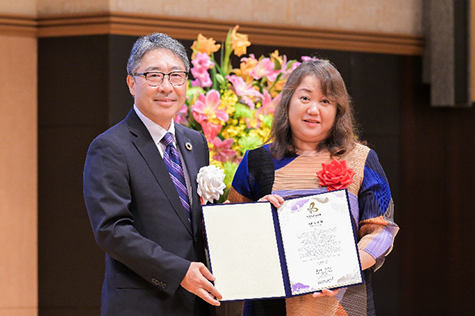
Left, Kurosawa Shinya, President of the Japan Foundation; right, Shiota Chiharu
The Association of Japanese Language Teachers of Mongolia has made major contributions to the development and popularization of Japanese-language education throughout Mongolia. Beginning in 1975 with a Japanese-language course offered by the National University of Mongoliaʼs Department of Literature, Japanese-language education has spread widely in the country, from elementary schools up through higher-education institutions. The Association, established in 1993, had 363 members when it was named an award recipient, and it holds Japanese-language speech contests and education symposiums in partnership with local Japan-related institutions and other entities. Since the year 2000, the Association has actively served as a local host institution for the Japanese-Language Proficiency Test. It is also engaged in developing and popularizing the Nihongo Dekirumon, a series of educational materials for the elementary and secondary levels based on the JF Standard for Japanese-Language Education. Each year, it holds several events related to Japanese-language education in its effort to raise the level of Japanese-language education and continue success in this area.
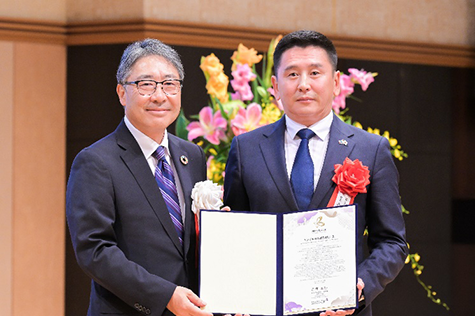
Right, Erdenebayar Batjargal, President of the Association of Japanese Language Teachers of Mongolia
The Sainsbury Institute for the Study of Japanese Arts and Cultures (SISJAC) is a research institution that was founded in 1999 with the financial support of Sir Robert and Lady Sainsbury. The Institute's mission is to promote research, publication, and exchange related to Japanese arts and cultures, and it is fast becoming one of the largest such research institutions in Europe. Many fellows and visiting researchers from around the world, including Japan, have worked at the Institute―more than 90 since its founding. Furthermore, one of the Institute's strategic partners, the University of East Anglia, recently launched the Masters in Interdisciplinary Japanese Studies program. The Institute's library holds a collection of over 50,000 historical records, which are being digitalized. Demonstrating flexibility, the SISJAC is expanding its areas of interest to include archaeology, manga, anime, and other Japan-related topics, and in this and other ways the Institute will continue to be immensely active as a core institution of Japanese research in Europe.
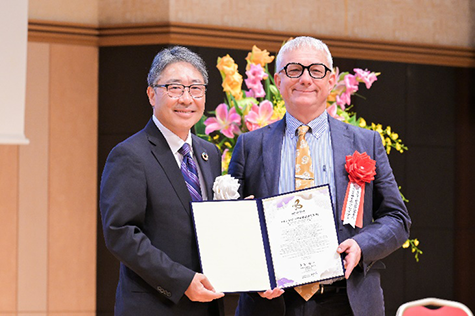
Professor Simon Kaner, Executive Director of the Sainsbury Institute for the Study of Japanese Arts and Cultures
After receiving their awards, the recipients spoke to the award ceremony attendees expressing their gratitude.
Shiota Chiharu spoke as follows:
Hello, everyone. I am Chiharu Shiota, an artist. I am truly delighted and honored to receive this award, which is more than I deserve. I am sincerely grateful.
An artist like me does not work at the request of others, and I don't receive orders every day. Neither can I necessarily sell my art after creating it, and I also find it quite difficult to connect with ordinary occupations. In many cases, I find myself wavering while I create my work, and I grapple on a daily basis with questions of whether my work is worthwhile or whether I could execute it better.
I thus feel truly overjoyed at having received a major award such as this, because it tells me that what I have been doing up to now has not been a mistake, and it is in some ways an affirmation that the work is good and that I can continue creating in this way. It is also an incentive to continue to create work into the future.
I have been creating works of art consistently for close to thirty years, but reflecting on it now, I can see that, in all honesty, there has been a succession of setbacks. Having traveled to Germany at the age of 24, I then battled cancer twice, and I even created some of my work while undergoing cancer treatment. A particularly difficult challenge for me was to continue showing my work overseas. In addition to facing language barriers and cultural differences, I was uncertain that my work would be accepted in foreign countries. However, I have received assistance with major international exhibitions from the Japan Foundation any number of times, and I am truly grateful for the Foundation's ongoing support.
I have enjoyed the Foundation's support on a great number of occasions, beginning with a group exhibition at the Ludwig Forum for International Art in Aachen in 2000. Other occasions include the Yokohama Triennale in 2001, which marked my debut in Japan; a one-woman show at the Japan Pavilion of the 56th Venice Biennale in 2015; and the exhibition at the Istanbul Modern to celebrate the 100th anniversary of the establishment of diplomatic relations between Japan and Turkey. It is quite literally thanks to the support of the Japan Foundation that I am able to hold exhibitions both domestically and overseas.
For me, my one-woman show at the Japan Pavilion of the 56th Venice Biennale in 2015 was a particularly unforgettable experience. The red thread that I use in my work is an expression of a human's complex emotions, memories, and unseen connections. Installing the work was difficult and involved many problems, but once I had successfully completed it and received a lot of encouragement, I got a real sense that my form of expression―namely, packing spaces with red thread―had transcended language and cultures to resonate with a large number of people. Through this experience, I once again became aware that despite differences in language and culture, human beings have fundamental emotions, memories, and experiences in common.
In addition to receiving assistance with my exhibitions from the Japan Foundation, I often hear that curators who have worked with me in the past sometimes receive invitations from the Foundation to enjoy the culture of Japan and deepen their knowledge of Japanese art. I also recall curators being pleased at the thought of working with more Japanese artists in the future.
Going forward, I hope to be motivated to create work that gives shape to my ideas and to stay humble and true to myself. I also hope that as a result of the Japan Foundation's continued support, Japanese art advances further internationally.
I would like to express my sincere gratitude to the art-museum personnel, galleries, collectors, and curators who have supported me up to now, as well as to the staff who have assisted me in my day-to-day activities.
Thank you very much.
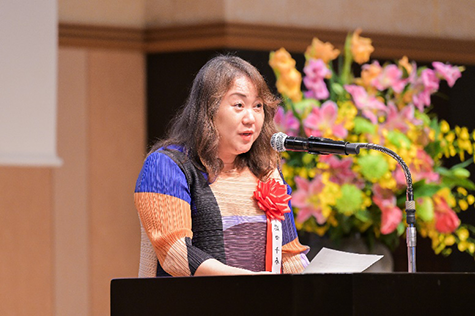
Shiota Chiharu speaking of her past work and participation in art exhibitions
Erdenebayar Batjargal, President of the Association of Japanese Language Teachers of Mongolia, gave the following speech:
The Association of Japanese Language Teachers of Mongolia feels beyond honored for its recent selection as a winner of a Japan Foundation Award, which is an extremely prestigious award. Every day, the Association of Japanese Language Teachers of Mongolia undertakes tasks to enhance the level of Japanese-language education in Mongolia, and to have those efforts unexpectedly recognized in this way―and to become Mongolia's first winner of a Japan Foundation Award―is hugely inspiring to all the Association's members, including me of course.
The Association of Japanese Language Teachers of Mongolia includes teachers from elementary, secondary, and higher-education institutions who have the best interests of Japanese-language education in Mongolia at heart, and it would have been absolutely impossible for the Association to get this far without the cooperation and support of those individuals. I would like to express my gratitude and offer my congratulations to the teachers whose efforts led to the establishment of the Association and to all the Japanese-language teachers who, through their involvement in Mongolia's Japanese-language education, have kindly provided regular support to the Association throughout its decades-long history.
The Association is also able to receive this award thanks to the ongoing cooperation and support of institutions, organizations, and individuals such as the Embassy of Japan in Mongolia, JICA, the Mongolia-Japan Center for Human Resources Development, the Association of Japanese in Mongolia, and the Japan-Mongolian Chamber of Commerce. I would like to once again express my gratitude to them.
Above all else, on behalf of the Association of Japanese Language Teachers of Mongolia, I would like to express my sincere appreciation to everyone at the Japan Foundation, which has made a huge contribution to the advancement of Japanese-language education in Mongolia and has continued to provide support and assistance over the years.
The history of Japanese-language education in Mongolia began in 1975 with the launch of a Japanese-language course at the National University of Mongolia's Department of Literature. With the year to year rise in the number of Japanese-language learners and teachers, in 1993 the Association of Japanese Language Teachers of Mongolia was founded, and in 1998 it was officially registered with the Ministry of Justice. According to the Survey on Japanese-Language Education Abroad 2021, the number of institutions offering Japanese-language education has grown to 28 elementary and secondary schools, 24 universities, and 66 private-sector Japanese-language schools. Membership at the Association of Japanese Language Teachers of Mongolia has increased to 363 people. The Association has focused its efforts on developing and popularizing Japanese-language education throughout Mongolia, as well as improving Japanese-language teachers' expertise and training Japanese-language support staff.
Currently, our key activities are the Interschool Japanese Language Speech Contest, held for the 30th time in 2024; a kanji-quiz contest known as the Kanji Naadam; and the Japanese Language Symposium, held once a year. I believe that these events, which are enthusiastically enjoyed by a large number of participants, contribute to the increase in Japanese-language learners and teachers and to mutual exchange. From 2000, the Association became a local host institution for the Japanese-Language Proficiency Test, holding the test in Ulaanbaatar City twice a year and in Arvaikheer City and Darkhan City once a year. The test is in such high demand that in July 2024 it attracted over 2,000 applicants. In addition, the Association holds the Examination for Japanese University Admission for International Students twice a year as the implementing cooperative agency for that exam. This exam is also attracting a growing number of examinees every year.
Furthermore, since 2012 the Association has been developing educational materials for elementary and secondary educational institutions based on the JF Standard for Japanese-Language Education. It has completed publication of the Nihongo Dekirumon series of textbooks, which has had a major impact on Japanese-language education within Mongolia, and is working to popularize them widely. Additionally, since 2013 the Association has been openly recruiting research theses at its subsidiary organization, the Research Group for Japanese Language Education, and it compiles the journal Japanese-Language Education in Mongolia. The seventh edition of the bulletin was published in 2023, and we plan to also issue it regularly in the future.
It is through activities like these that the Association encourages understanding of Japan in Mongolia and strengthens the relationship between the two countries. I believe that this superb award has been conferred upon the Association in recognition of accomplishments such as these, which makes me extremely happy. I would like to once again express my gratitude.
This prestigious award will encourage us all the more. The relationship between Japan and Mongolia and exchanges between the two countries will undoubtedly proceed further. To ensure that the Association of Japanese Language Teachers of Mongolia can contribute to that, we intend to draw on the assistance of others as we continue our activities with even greater diligence.
Your continued support is greatly appreciated. Thank you very much.
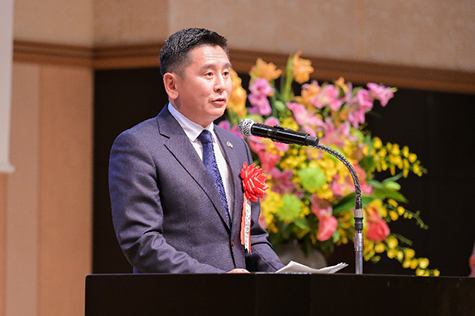
Erdenebayar Batjargal talking about the development of Japanese-language education in Mongolia
Professor Simon Kaner, Executive Director of the Sainsbury Institute for the Study of Japanese Arts and Cultures, gave the following speech:
Twenty-five years ago, our founding benefactors, Sir Robert and Lady Lisa Sainsbury, established the Sainsbury Institute for the Study of Japanese Arts and Cultures. Our mission is to undertake and disseminate world-class research on all aspects of Japanese arts and cultures, from Hokkaido to Okinawa, from the past to the present. Over the past quarter century we have grown from a small two-person operation to one of the greatest constellations of expertise in Japanese arts and cultures outside Japan. We work in partnership with practitioners and academics, universities, museums, galleries, and research institutes across Japan, the UK, elsewhere in Europe, and the Americas. Through tracking our social media and online presence, we know we have a global footprint.
On behalf of everyone involved in our Institute, I want to say how tremendously honoured we are to be selected for a Japan Foundation Award in ouranniversary year. The Japan Foundation has been at our side since the inception of our Institute, providing invaluable support for our activities, including conferences, publications, exhibitions and, through our strategic partnership with the University of East Anglia, lectureships in artistic heritage and literature, and assistance with the promotion of Japanese-language learning through the Sakura Network.
I believe that arts and cultures are an essential, integral part of what it means to be human. Sometimes arts and cultures are considered a distinct sector of human endeavour, removed from politics and economics, somehow peripheral to history. I profoundly disagree with this view. As an archaeologist, I have been privileged to work with artworks from tens of thousands of years ago, produced as modern human beings evolved, as well as with wonderful contemporary artists inspired by the ancient past. Arts and cultures make us human. In today's troubled but unprecedentedly connected world, I believe that mutual understanding through arts and cultures has never been more important. To paraphrase the British auteur Simon McBurney, culture is the solution in which we all bathe.
The activities of the Japan Foundation are a beacon for the promotion of arts and cultures. As the chief executive of Arts Council England, Darren Henley has written that there is an immense dividend, the "Arts Dividend," to be generated through investing in arts and cultures. Arts and cultures offer ways forward to cope with our global and local challenges: dealing with disasters, climate change, health and ageing, conflict and regeneration, to name but a few. The Sainsbury Institute is humbled and grateful to receive this prestigious Japan Foundation Award. I sincerely thank everyone who has accompanied us on our journey to date and look forward to further unlocking the "Arts Dividend" to the benefit of all.
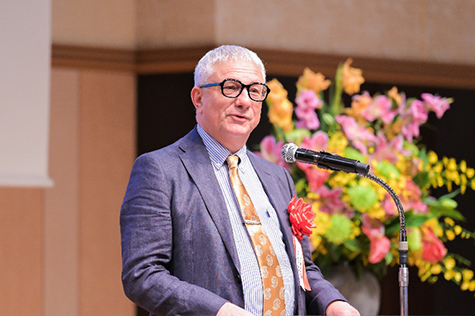
Professor Kaner discussing mutual understanding through arts and cultures
After the award ceremony, the Japan Foundation Awards Reception was held.
The Award recipients were surrounded by many attendees who congratulated them on their past achievements, and everyone enjoyed lively conversation.
Text: Nishino Yumiko, Public Relations Division, The Japan Foundation
Related Articles
Keywords
Back Issues
- 2025.9.30 The 51st Japan Found…
- 2025.9.30 The Japan Foundation…
- 2025.9.30 Bringing the World C…
- 2025.9.30 The 51st (2024) Japa…
- 2025.9.30 Japan Foundation Pri…
- 2025.9.30 Japan Foundation Pri…
- 2024.5.24 The 50th Japan Found…
- 2024.3. 4 Movie Theaters aroun…
- 2023.4.10 The 49th Japan Found…
- 2023.3.28 JF's Initiatives for…

